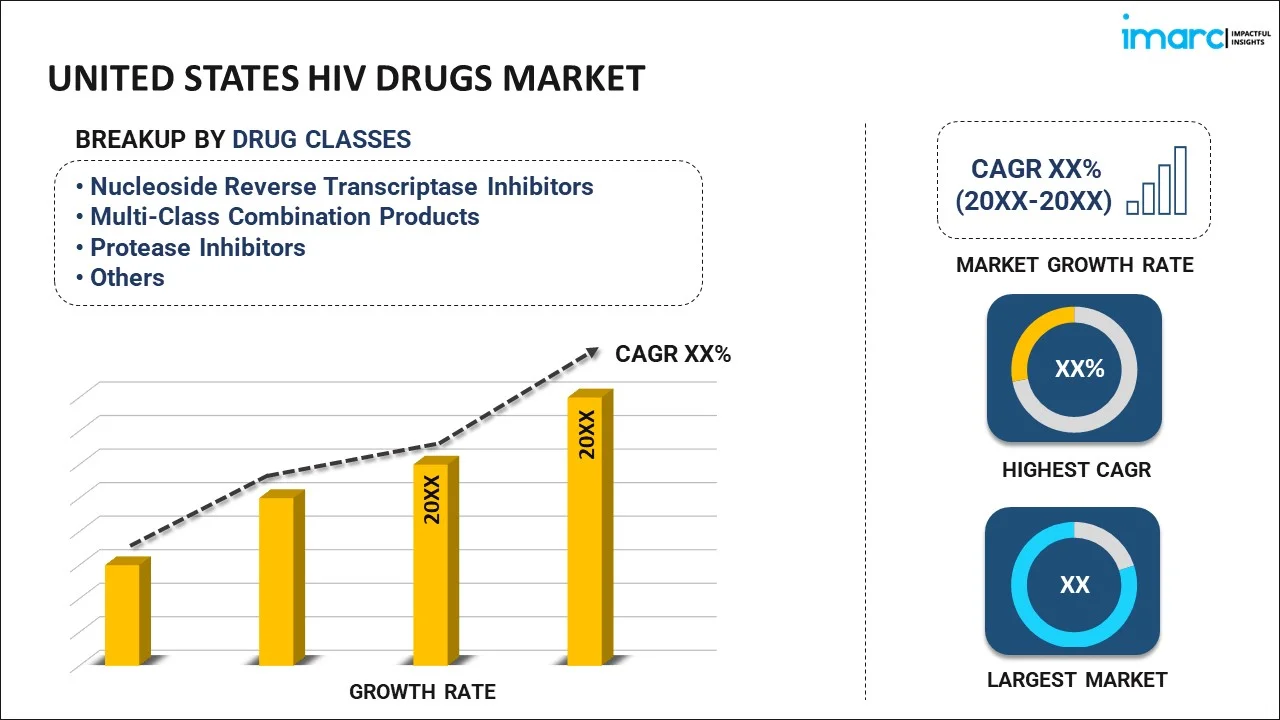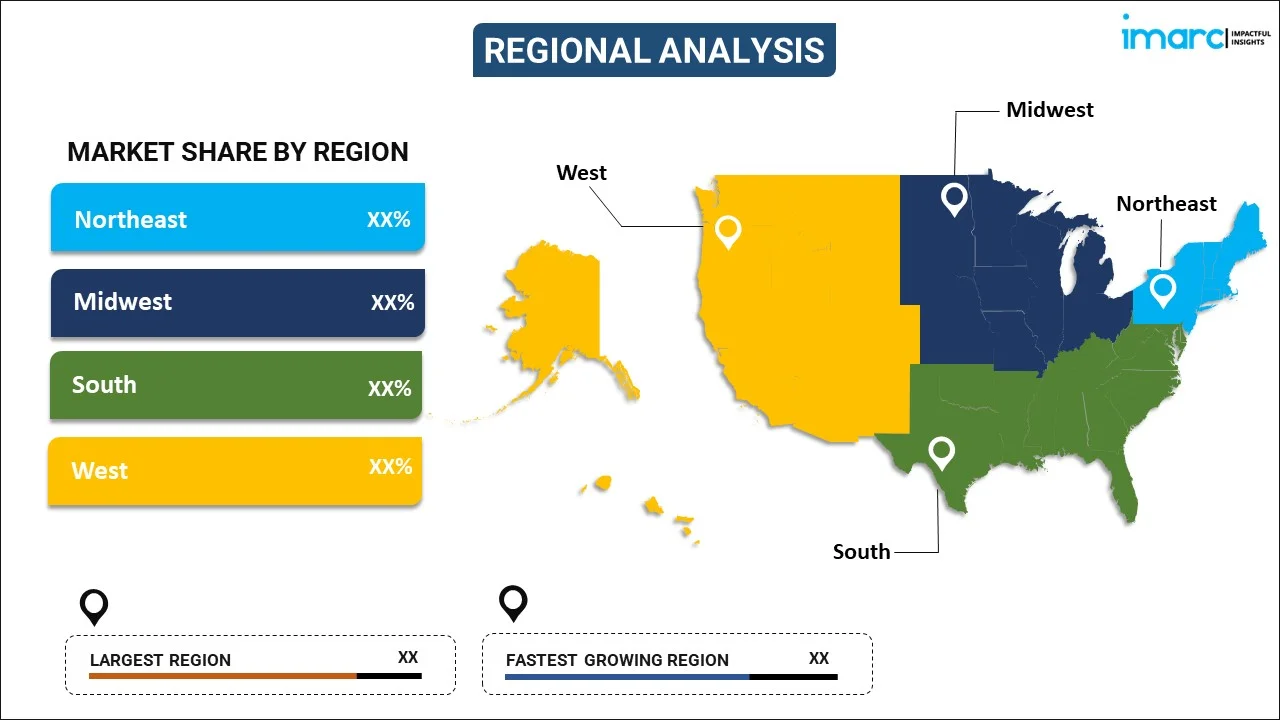
United States HIV Drugs Market Report by Drug Class (Nucleoside Reverse Transcriptase Inhibitors, Multi-Class Combination Products, Protease Inhibitors, HIV Integrase Strand Transfer Inhibitors, Non-Nucleoside Reverse Transcriptase Inhibitors, Entry Inhibitors — CCR5 Co-Receptor Antagonist, Fusion Inhibitors, and Others), Distribution Channel (Hospital Pharmacies, Retail Pharmacies, Online Pharmacies, and Others), and Region 2025-2033
Market Overview:
United States HIV drugs market size reached USD 7.8 Billion in 2024. Looking forward, IMARC Group expects the market to reach USD 12.3 Billion by 2033, exhibiting a growth rate (CAGR) of 5.2% during 2025-2033. The inflating popularity of antiretroviral therapy (ART) for optimal management of the infection is primarily driving the market growth across the country.
|
Report Attribute
|
Key Statistics
|
|---|---|
|
Base Year
|
2024 |
|
Forecast Years
|
2025-2033
|
|
Historical Years
|
2019-2024
|
| Market Size in 2024 | USD 7.8 Billion |
| Market Forecast in 2033 | USD 12.3 Billion |
| Market Growth Rate (2025-2033) | 5.2% |
HIV, short for human immunodeficiency virus, belongs to the retrovirus category and adversely affects the immune system by targeting and destroying CD4 cells, the white blood cells crucial for combating infections. The treatment approach for HIV infection is referred to as antiretroviral therapy (ART), involving the use of specific HIV drugs. Those undergoing ART are required to adhere to a daily HIV regimen, consuming a prescribed combination of medications. While this therapy doesn't offer a cure for HIV, it significantly improves the quality of life for individuals with the infection, allowing them to lead longer and healthier lives. HIV drugs play a pivotal role in inhibiting the replication of the virus, providing a potential pathway for recovery. By bolstering the immune system, these medications empower the body to resist certain infections and mitigate HIV-related complications.
United States HIV Drugs Market Trends:
The United States HIV drugs market stands as a critical component in the nation's healthcare landscape, addressing the ongoing challenges posed by human immunodeficiency virus. Additionally, the regional market encompasses a spectrum of medications utilized in ART regimens, requiring patients to adhere to a daily prescribed combination for optimal management of the infection. While HIV drugs do not provide a cure, they significantly enhance the longevity and well-being of individuals, which is acting as significant growth-inducing factor. Besides this, the market reflects a commitment to ongoing research and development, continually introducing innovative drugs to combat the virus and enhance treatment outcomes. These medications work by impeding the replication of the virus, providing individuals with a better chance at recovery and an improved quality of life. The United States, with its advanced healthcare infrastructure, remains at the forefront of HIV drug development and accessibility. Apart from this, the nation's dedication to combating infectious diseases and fostering advancements in medical science is expected to fuel the market growth over the forecasted period.
United States HIV Drugs Market Segmentation:
IMARC Group provides an analysis of the key trends in each segment of the market, along with forecasts at the country level for 2025-2033. Our report has categorized the market based on drug class and distribution channel.
Drug Class Insights:

- Nucleoside Reverse Transcriptase Inhibitors
- Multi-Class Combination Products
- Protease Inhibitors
- HIV Integrase Strand Transfer Inhibitors
- Non-Nucleoside Reverse Transcriptase Inhibitors
- Entry Inhibitors — CCR5 Co-Receptor Antagonist
- Fusion Inhibitors
- Others
The report has provided a detailed breakup and analysis of the market based on the drug class. This includes nucleoside reverse transcriptase inhibitors, multi-class combination products, protease inhibitors, HIV integrase strand transfer inhibitors, non-nucleoside reverse transcriptase inhibitors, entry inhibitors — CCR5 co-receptor antagonist, fusion inhibitors, and others.
Distribution Channel Insights:
- Hospital Pharmacies
- Retail Pharmacies
- Online Pharmacies
- Others
A detailed breakup and analysis of the market based on the distribution channel have also been provided in the report. This includes hospital pharmacies, retail pharmacies, online pharmacies, and others.
Regional Insights:

- Northeast
- Midwest
- South
- West
The report has also provided a comprehensive analysis of all the major regional markets, which include Northeast, Midwest, South, and West.
Competitive Landscape:
The market research report has also provided a comprehensive analysis of the competitive landscape in the market. Competitive analysis such as market structure, key player positioning, top winning strategies, competitive dashboard, and company evaluation quadrant has been covered in the report. Also, detailed profiles of all major companies have been provided.
United States HIV Drugs Market Report Coverage:
| Report Features | Details |
|---|---|
| Base Year of the Analysis | 2024 |
| Historical Period | 2019-2024 |
| Forecast Period | 2025-2033 |
| Units | Billion USD |
| Scope of the Report | Exploration of Historical and Forecast Trends, Industry Catalysts and Challenges, Segment-Wise Historical and Predictive Market Assessment:
|
| Drug Classes Covered | Nucleoside Reverse Transcriptase Inhibitors, Multi-Class Combination Products, Protease Inhibitors, HIV Integrase Strand Transfer Inhibitors, Non-Nucleoside Reverse Transcriptase Inhibitors, Entry Inhibitors — CCR5 Co-Receptor Antagonist, Fusion Inhibitors, Others |
| Distribution Channels Covered | Hospital Pharmacies, Retail Pharmacies, Online Pharmacies, Others |
| Regions Covered | Northeast, Midwest, South, West |
| Customization Scope | 10% Free Customization |
| Post-Sale Analyst Support | 10-12 Weeks |
| Delivery Format | PDF and Excel through Email (We can also provide the editable version of the report in PPT/Word format on special request) |
Key Questions Answered in This Report:
- How has the United States HIV drugs market performed so far and how will it perform in the coming years?
- What has been the impact of COVID-19 on the United States HIV drugs market?
- What is the breakup of the United States HIV drugs market on the basis of drug class?
- What is the breakup of the United States HIV drugs market on the basis of distribution channel?
- What are the various stages in the value chain of the United States HIV drugs market?
- What are the key driving factors and challenges in the United States HIV drugs?
- What is the structure of the United States HIV drugs market and who are the key players?
- What is the degree of competition in the United States HIV drugs market?
Key Benefits for Stakeholders:
- IMARC’s industry report offers a comprehensive quantitative analysis of various market segments, historical and current market trends, market forecasts, and dynamics of the United States HIV drugs market from 2019-2033.
- The research report provides the latest information on the market drivers, challenges, and opportunities in the United States HIV drugs market.
- Porter's five forces analysis assist stakeholders in assessing the impact of new entrants, competitive rivalry, supplier power, buyer power, and the threat of substitution. It helps stakeholders to analyze the level of competition within the United States HIV drugs industry and its attractiveness.
- Competitive landscape allows stakeholders to understand their competitive environment and provides an insight into the current positions of key players in the market.
Need more help?
- Speak to our experienced analysts for insights on the current market scenarios.
- Include additional segments and countries to customize the report as per your requirement.
- Gain an unparalleled competitive advantage in your domain by understanding how to utilize the report and positively impacting your operations and revenue.
- For further assistance, please connect with our analysts.
 Inquire Before Buying
Inquire Before Buying
 Speak to an Analyst
Speak to an Analyst
 Request Brochure
Request Brochure
 Request Customization
Request Customization




.webp)




.webp)












